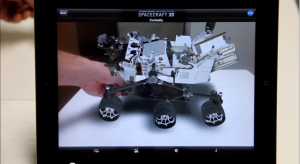Question: What does a 15th Century oil painting have to do with the development of NASA’s Augmented Reality iPad App?
I’m always interested in the connections that today’s digital devices have with history. Take for example, NASA’s Augmented Reality App (http://bit.ly/GA82dS). Imagine printing a simple image from your inkjet printer. Then placing the printed paper on your desk, and then turning on your NASA app and iPad camera to scan the printed image on the desk (fig. 1). Suddenly, as if by magic, up pops up a model of the Mar’s Rover, with the appearance of taking up space and volume, but no weight!? (fig. 2). Finally, you have the ability to pick up the model and view it from 360 degrees, as well as animate many of its functions (activating its’ antenna, or moving it a few degrees.) (see figures 1-3)
Fig 1. Printed paper being scanned by iPad camera
 Fig. 2: NASA app locks on to image and Mar’s Rover pops up.
Fig. 2: NASA app locks on to image and Mar’s Rover pops up.
Fig 3: Rover can be turned and viewed in 360 degrees.
As I viewed the image on my iPad and enjoyed the ability to see a 3D image that I could move and maneuver in the palm of my hand I marveled with the science fiction I was playing with. In the palm of my hand was the result of years of science, technology, engineering and mathematics; and yet, one crucial element in history had been overlooked. In order to appreciate the full visual affect I was enjoying with this Augmented Reality App I wondered if this was the same wonderment experienced by the few people who saw Filippo Brunelleschi’s painting of the Baptistry in Florence, Italy, 600 years ago. Brunelleschi was a man who was an engineer, architect, artisan, mathematician, and inventor.
Prior to Brunelleschi’s work, artist’s painted and drew in a flat plane with figures that had no weight and sometimes seemed to float in space. Perspective wa s not important. For example, the castle in the painting (Left) looks like some child’s doll house with no depth, no perspective. The three figures behind the churchman also seem to have no order of depth–no perspective.
s not important. For example, the castle in the painting (Left) looks like some child’s doll house with no depth, no perspective. The three figures behind the churchman also seem to have no order of depth–no perspective.
Brunelleschi’s work would literally change history and how people would view the world because of rediscovered geometry called “linear perspective.” Without linear perspective today’s video games, movies, holographic projections, virtual reality, and apps like Augmented Reality would not exist. Brunelleschi was the first to introduced the geometry that would gave way to these discoveries and inventions. Using a mirror, he was able to understand how all lines converged to one point. Mapping this information out on a canvas he painted the Baptistry building in Florence, Italy. People were encouraged to view the painting by looking through a hole made at the bottom of the canvas and placing a half mirror at a distance (see figure below) that would reflect the artists work and then give view to the real building. The whole experience had a wow affect. This new discovery would change how artists would paint, and even how maps were to be made. In effect, our 21st Century GPS also has its history to this same event in history. Art is another form of recording data and information, and yet it is many times over looked and shoved aside due to bias and ignorance.
Leonardo da Vinci said, “There are three classes of people: those who see. Those who see when they are shown Those who do not see.” It’s important to remember we see and think in images not words. Technology won’t motivate, but Art has the power to motivate and create, and in the end, isn’t that what we, as educators, are striving for, ways to motivate and encourage our students?




